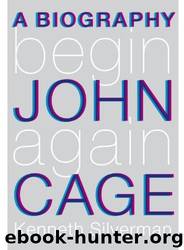Begin Again: A Biography of John Cage by Kenneth Silverman

Author:Kenneth Silverman
Language: eng
Format: mobi, epub
Tags: Composers, Composers - United States, John, Classical, Cage, Individual Composer & Musician, General, United States, Music, Biography & Autobiography, Genres & Styles, Composers & Musicians, Biography
ISBN: 9781400044375
Publisher: Random House, Inc.
Published: 2010-10-19T10:00:00+00:00
Awards; Professorship at Illinois; Lejaren Hiller; Musicircus
Cage’s much-publicized electronic works brought him awards and honors. He received a grant from ASCAP, a fifteen-hundred-dollar grant from the Koussevitzky Music Foundation, a five-thousand-dollar grant from the Thorne Music Fund. The New York State Council on the Arts engaged him for seven appearances in its Contemporary Voices in the Arts series. From England, the University of York offered him an honorary doctorate of philosophy. He turned it down because he had never graduated college, promising not to accept any other honorary degrees that might be offered in the future. But he accepted election to the prestigious American Institute of Arts and Letters. And he raised his concert fee to a thousand dollars—an “outlandish” amount, he said, that he requested “in order to discourage engagements so that I can get some work done.”
The work Cage got done was on a sensational, Barnumesque scale. Beginning in September 1967, he accepted a one-year appointment at the University of Illinois as Visiting Research Professor in the School of Music. A large public institution, the school had a long history in music instruction and sponsored a monthlong festival of contemporary arts, which had brought to campus among others Igor Stravinsky. The position entailed few obligations. Cage had no formal contact with students, although some sought him out. He had time to dine and play bridge with the composer Ben Johnston and his wife, and to wander off for other things, as he did in occasionally touring with Cunningham’s company.
Cage began his professorship exuberantly. In November, two months after arriving at the university, he produced what he called Musicircus. He later dated the concept to his 1931 visit to Seville, where he had enjoyably watched a number of unlike visual and sonic events going on together on a street corner. Many cultures have no idea of a ‘concert,’ and his ‘score’ for Musicircus was no more than an invitation to some musicians to perform simultaneously whatever they wanted, in any way. “People will be all over the place,” he anticipated, “making music all at once.” The place was the university’s Stock Pavilion, used for showing cattle.
An estimated five thousand people attended, free of charge. They experienced what Cage called “my notion that many musics may be heard at one & the same time.” All at once they took in a piano recital, a baroque orchestra, a jazz band, silhouetted movements of some Cunningham dancers, David Tudor electronically amplifying the noise of the ventilator, a mime pretending to fight against a wall of sound, and Cage himself operating the lighting console, contact microphones broadcasting its clicking switches. Next day at a university symposium he commented that art is social—not “someone saying something, but people doing things. Giving everyone, including those involved, the opportunity to have experiences they would not have had otherwise.”
In accepting the visiting professorship at Illinois, Cage noted that it would give him access to a powerful electronic device that was new to him: the computer. “What in Heavens Name,” he wondered, “will I do with it?” He ended up doing very much with it.
Download
Begin Again: A Biography of John Cage by Kenneth Silverman.epub
This site does not store any files on its server. We only index and link to content provided by other sites. Please contact the content providers to delete copyright contents if any and email us, we'll remove relevant links or contents immediately.
| Actors & Entertainers | Artists, Architects & Photographers |
| Authors | Composers & Musicians |
| Dancers | Movie Directors |
| Television Performers | Theatre |
Cecilia; Or, Memoirs of an Heiress — Volume 2 by Fanny Burney(31871)
Cecilia; Or, Memoirs of an Heiress — Volume 3 by Fanny Burney(31852)
Fanny Burney by Claire Harman(26526)
We're Going to Need More Wine by Gabrielle Union(18967)
Plagued by Fire by Paul Hendrickson(17331)
All the Missing Girls by Megan Miranda(15565)
Cat's cradle by Kurt Vonnegut(15183)
Bombshells: Glamour Girls of a Lifetime by Sullivan Steve(13972)
Leonardo da Vinci by Walter Isaacson(13181)
For the Love of Europe by Rick Steves(12977)
4 3 2 1: A Novel by Paul Auster(12281)
Adultolescence by Gabbie Hanna(8857)
The remains of the day by Kazuo Ishiguro(8820)
Note to Self by Connor Franta(7621)
Diary of a Player by Brad Paisley(7487)
Giovanni's Room by James Baldwin(7189)
What Does This Button Do? by Bruce Dickinson(6134)
Ego Is the Enemy by Ryan Holiday(5294)
Born a Crime by Trevor Noah(5294)
